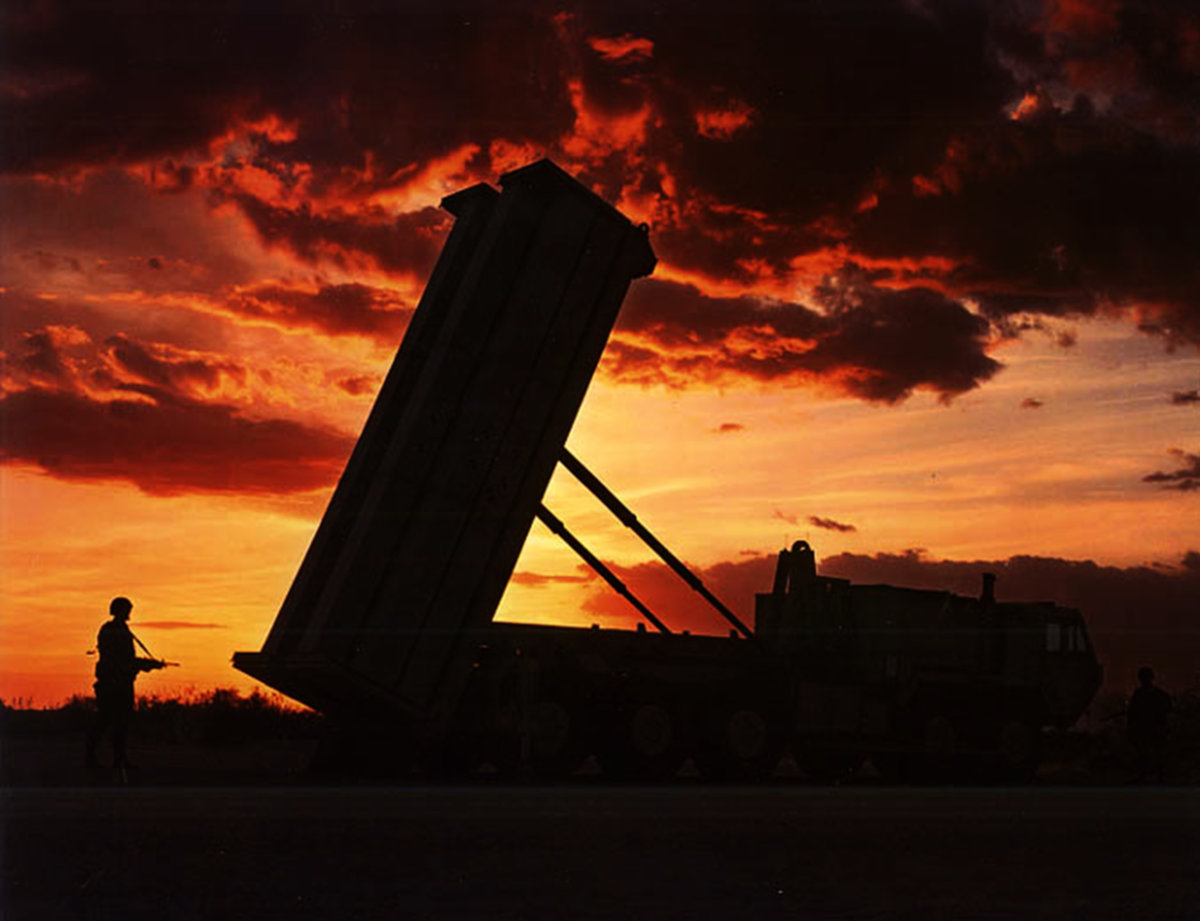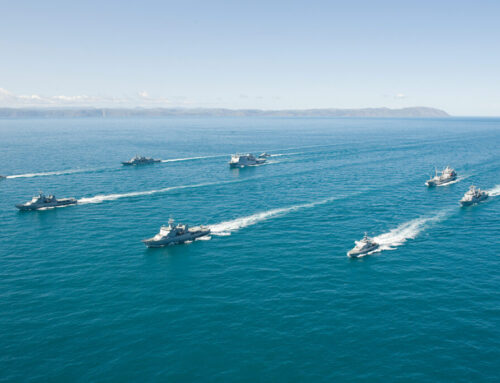PP COMMENTARY Missile defense of the United States
Autor foto: Domena publiczna

Missile defense of the United States
August 19, 2016
Author: Maciej Kowalski


PP COMMENTARY Missile defense of the United States
Autor foto: Domena publiczna
Missile defense of the United States
Author: Maciej Kowalski
Published: August 19, 2016
History
The origins of the Ballistic Missile Defense (BMD) of the United States are associated with the Cold War arms race with the Soviet Union. Arsenals of ballistic missiles armed with nuclear warheads were the primary means of deterrence used by the two superpowers, directly threatening populations and strategic civilian and military targets of the opponent.
In 1958, missile defense became one of the tasks of the U.S. Army, which resulted in the development of the first BMD system called Nike-Zeus. BMD development programs were continued in subsequent years under various names (Sentinel, Safeguard) until the agreement with the Soviet Union to limit missile defense programs (the ABM Treaty) was signed in 1972. The system imposed significant restrictions on the development of strategic missile defense systems, while allowing work on the theatre missile defense (TMD) systems.
In 1983, President Ronald Reagan announced changes in the U.S. BMD strategy, which resulted in formation of the Strategic Defense Initiative Organization (SDIO) a year later. SDIO centralized programs for missile defense conducted by various branches of US armed forces. The task placed before SDIO, i.e. building a system of defense against strategic nuclear warheads of the Soviet Union, broke the spirit of the ABM Treaty. However, from a legal point of view, it did not infringe any of the provisions of the Treaty.
The end of the Cold War and the attacks on U.S. troops by Iraqi tactical ballistic missiles during the first Gulf War, once again refocused American efforts towards development of TMD systems. In 1993, SDIO became the Ballistic Missile Defense Organization (BMDO) and development of strategic defense was limited to a ‘Technology Readiness Program.’
Another shift came during the 1990s with increased threat coming from the so-called “rogue states”, such as North Korea or Iran. The issue of homeland defense was brought forward by the Rumsfeld’s Commission report of 1998, which was the basis for the National Missile Defense Act passed in 1999. The law established the goals of the U.S. BMD strategy which still hold true today: defense of the homeland territory, troops and allies of the United States. After the U.S. withdrawal from the ABM treaty in 2002, the limitations to BMD development disappeared. The BMDO was renamed (and remains to the present day) the Missile Defense Agency (MDA).
System Tasks (Threats)
The National Missile Defense Act of 1999 established an official national task to run ‘in the shortest possible time, a system protecting the United States against a limited ballistic attack.’ Similarly, the MDA’s statutory goal is the creation of a system for defense of the United States, its armed forces oversees and allies from attacks by ballistic missiles of all ranges in every phase of their flight. This is to be achieved through ‘development, testing, and fielding [of] an integrated, layered, ballistic missile defense system (BMDS)’.
System Architecture
Currently, the BMDS is composed of 11 programs, which mostly fall under the supervision of the MDA.
- Command and Control Battle Management and Communications
The Command and Control, Battle Management and Communication (C2BMC) is a battle management system, which integrates the effectors and radars of the BMDS. It enables the decision makers to preview all the sensors and manage engagements in real time. In particular, it creates a ‘common, single, integrated ballistic missile picture,’ and will eventually combine data from all of BMDS components.
- Ground Midcourse Defense
Ground-based Midcourse Defense armed with the Ground Based Interceptors (GBI) was the first BMDS sub-system to gain operational capability, coming online in 2004. It is designed to combat incoming missiles of intermediate (3000-5500 km, the so-called Intermediate-Range Ballistic Missile – IRBM) and intercontinental (over 5500 km, the so-called Intercontinental Ballistic Missiles – ICBM) range in the middle phase of their flight (outside of the atmosphere). GBIs are a three-degree, solid fuel missiles, which destroy targets using a kinetic head (Exoatmospheric Kill Vehicle). The head has its own guidance system with infrared sensors and a system of communication with the command center. A total of 30 silos with missiles are located in Fort Greely in Alaska and Vandenberg Air Force Base in California. The fire control functions are performed out of US Air Force bases in Alaska and Colorado.
- AEGIS system
The AEGIS Ballistic Missile Defense system is operational on 33 destroyers and cruisers of the U.S. Navy. It is equipped with a family of Standard Missile interceptors. The system performs a dual function, providing regional and national (strategic) missile defense. Regional defense is aimed towards combating short- (< 1000 km), medium- (1000-3000 km) and intermediate-range ballistic missiles in the middle phase of their flight using SM-3 missiles and short-range ballistic missiles in the final phase of their flight using of SM-2 Block IV missiles and, in the near future, SM-6 Dual I / II missiles. The objectives of national (strategic) defense are achieved by collecting radar data (AN / SPY-1 radar) which is then transferred to other BMDS sensors, interceptors of the GMB system, and other AEGIS ships. Deployment of warships equipped with the AEGIS system in the Mediterranean region is part of the European Phased Adaptive Approach (EPAA) and the US voluntary contribution to NATO missile defense system (NATO BMD).
- AEGIS Ashore
A land-based variant of the AEGIS system called AEGIS Ashore was designed to ‘protect U.S. troops and allies in Europe against a ballistic attack from the Middle East.’ The Aegis Ashore system very closely resembles its maritime predecessor. As part of the second and third stage of the EPAA, Aegis bases in Devesulu (Romania) and Redzikowo (Poland) will be equipped with 24 short to intermediate range SM-3 IB and SM-3 IIA missiles each, radars and communication systems. The base in Devesulu became operational in May 2015, while Redzikowo is to be launched in 2018.
- UEWR (Upgraded Early Warning Radars)
Upgraded Early Warning Radars are long distance sensors and the backbone of BMDS early warning capability. Their role is to provide real-time information about hostile missile take off and potential impact sites to the command centers. There are currently 3 UEWR radars: in Beale Air Force Base, California, in the Royal Air Force base in Fylingdales in the UK and in the Thule Air Force Base in Greenland. They have two (Beale, Thule) or three (Fylingdales) antennas scanning the airspace with phased array beam and at a distance of 3000 miles (4800 km).
- Cobra Dane
Cobra Dane radar (AN / FPS-108) in the Eareckson Air Station in Alaska fulfills similar functions to the UEWR. Historically, it was used to observe the territory of the Soviet Union and to verify compliance with the SALT II disarmament treaty. It possesses a single antenna with a steering beam covering 136 degrees in azimuth and observes objects using the L-band frequency at a distance of up to 2,000 miles (3200 km). Cobra Dane detects, tracks, and classifies objects, providing quality data and enabling target identification, transfer of information to BMDS, firing interceptor missiles and updating their courses.
- Sea Based Radar
Sea-Based Radar (SBX) is a maritime sensor operating in X-band frequency, which is installed on an adapted, mobile oil platform. It is located in the Pacific Ocean and used both during BMDS tests and as a source of data about possible threats flying over the Pacific Ocean.
- Space Tracking and Surveillance System
Space Tracking and Surveillance System is a pilot project of MDA, consisting of satellites – technology demonstrators of BMDS space layer. The two satellites were placed in the orbit 1350 km from the Earth in 2009. Both possess sensors of visible and infrared light. Their primary goal is to provide accurate information on the positions of ballistic warheads and transfer it to the BMDS, GMD missiles and AEGIS ships.
- THAAD
Terminal High Altitude Area Defense system fights ballistic missiles in their final phase of flight, both outside the atmosphere (Exoatmospheric kill) and after re-entry (endoatmospheric kill). Targets are destroyed kinetically (hit-to-kill) at high altitudes, thus minimizing the risk associated with warheads containing weapons of mass destruction. Currently, there are 5 operational THAAD batteries, equipped with a total of 144 interceptors. Each battery consists of several missile launchers with eight missiles each, one AN / TPY-2 radar, fire control station, auxiliary components and spare missiles. THAAD is a U.S. Army program, although most of the development and production (e.g. interceptors) is subject to MDA.
- AN/TPY-2 Radar
The AN/ TPY-2 radar is the most capable mobile radar operating in the X-band frequency in the world. There are 10 AN / TPY-2 radars in service. Five of them operate in a Terminal Based Mode as THAAD battery components, detecting, tracking and differentiating targets and managing the firing of interceptor missiles. The other five, working in a Forward Based Mode, act as early warning sensors deployed close to potential threat, and source of boost phase data for the BMDS. They are located, inter alia, on U.S. allies’ territories – Turkey, Israel and Japan (2 pieces). The radar located in Turkey has been deployed as part of the first EPAA phase.
- PATRIOT
The PATRIOT (Phased Array Tracking to Intercept On Target) system represents the lowest layer of the BMDS. The currently fielded configuration, Patriot Advanced Capability-3, is a point air and missile defense system, designed to fight, inter alia, short-range ballistic missiles in the final phase of their flight. In total, there are 43 PATRIOT battalions serving in armed forces of 13 countries around the world. This translates into more than 220 fire units and 1,100 launchers. The 15 battalions serving in the US Army defend American military bases overseas and to provide limited territorial defense of US allies.
There are three missiles, currently operational with PATRIOT, which possess anti-missile capabilities: PAC-3, PAC-3 MSE (both hit-to-kill) and PAC-2 GEM-T (fragmentation warhead with the explosive). In the most typical, mixed PAC-2 / PAC-3 configuration, a PATRIOT battery provides protection against short-range ballistic missiles to an area of approximately 15 to 20 km2. A single fire unit is comprised of one AN/MPQ-65, 4 GEM-T missiles launchers (4 missiles each), 2 MSE missile launchers (16 missiles each), fire control station and auxiliary vehicles.
Unlike other elements of the BMDS system, the development of PATRIOT is supervised by US Army’s Program Executive Office (PEO), as part of a broader task of providing American troops with an Army Integrated Air and Missile Defense (AIAMD). The US committed to use the system until at least 2048 and has been gradually modernizing its elements. Most importantly, the PEO is overseeing development and deployment of the IAMD Battle Command System (IBCS), which will eventually form a net-centric, “common mission command across all Army AMD echelons.” The IBCS / C2BMC interoperability is scheduled to be fielded by 2020. In this way PATRIOT would become integrated with the BMDS as the last defense line against a ballistic attack.
Future Developments
1) Systems under the supervision of the Missile Defense Agency
In the short term, the development of BMDS focuses on a quantitative increase in equipment and evolutionary upgrades of subsystems (the so-called Spiral Developments). In 2017 the following missiles will be delivered: 14 additional GBIs (for a total of 44 missiles), 39 SM-3 Block IB missiles (a total of 146) and 61 THAAD missiles (205 supplied since May 2011). The production of the sixth and seventh THAAD battery will be completed, and the work will be continued on the second AEGIS Ashore base (in Redzikowo). The construction of the Long Range Radar Discrimination (LRDR) will also begin in 2017. The sensor will significantly increase the ability to detect and track targets in the Pacific region.
In the following years, new versions of combat and command systems will be put into service. At the end of the fiscal year 2017 (October 2016 – September 2017) the 8.2-1 version of the C2BMC system will be launched, which will integrate data from SBX, UEWR, Cobra Dane radars as well as from multiple AN / TPY-2s. This will allow for quintupling the system raid size and tracking capacity. The BMDS picture will also be supplemented by data provided by Army sensors operating in the IBCS environment, including PATRIOT radars. Achieving initial interoperability by IBCS and C2BMC is scheduled for 2019.
At the same time, given the high cost of currently utilized systems and kinetic missiles, alternative technologies are being developed. Notably, just the development of missiles of the BMDS system (PAC-3, THAAD, SM-3, GBI, etc.) has cost more than 25 billion USD over the last 17 years. Therefore, BMDS long-term goal is the deployment of cost-effective directed energy systems, placed on long-range unmanned aircraft flying at high altitudes. The UAVs would destroy ICBM missiles in the initial phase of their flight (boost phase) over the territory of the enemy using a laser beam technology. MDA agency has already granted five contracts for the construction of the prototype lasers that would fit on aircraft.
2) Systems under the supervision of the U.S. Army – PATRIOT
The Program Executive Office of the U.S. Army, in collaboration with foreign users of the system, is planning to continue modernization of the existing PATRIOT batteries. Currently, the Post Deployment Build-8 version is being fielded. Other changes include improvements or replacement of command station and communications system (Modern Adjunct Processor, Tactical Transportable Troposcatter) and radar (Digital Radar Processor, Digital Side Lobe Canceller). These changes would allow, inter alia, the implementation of PAC-3 MSE missiles in 2017, which would increase the effectiveness of the system against ballistic threats. An increase in the effectiveness of defense against tactical ballistic missiles (version PDB-8.1) and the implementation of Electronic Counter-Countermeasure (PDB-8.05) are also planned in the coming years.
Land forces will continue deployment of the Integrated Air and Missile Defence Battle Command System (IBCS) as well as integration of legacy PATRIOT components and other air defense systems in the system structure. Special adapter kits allow for the inclusion of non-network centric components, such as the AN/MPQ-65 radar, in the IBCS’ Integrated Fire Control Network. Initial operational readiness for IBCS is scheduled for 2018, and all 15 PATRIOT battalions will be equipped with this system by 2025. .
The U.S. Congress and the Department of Defense have been working on the selection of a successor to replace the AN / MPQ-65 radar and launchers. The issuance of a request to acquire the radar is expected not earlier than in 2019, and its implementation could happen in about 2028.
Conclusions and recommendations
- The USA has been developing missile defense systems for over 70 years and the BMDS for over 20. Despite that, currently the BMDS is capable of countering only a limited ballistic attack, and even this could not have been achieved without a high-priority status within the Department of Defense’s projects. Therefore if the Polish air defense system is to be effective against ballistic threats, it ought to receive the highest priority in the Armed Forces Technical Modernization Program.
- ‘The complex demands of developing and integrating a BMDS capable of defeating ballistic missiles of all ranges in all phases of flight require a level of management, engineering, analytic, and leadership capabilities that approaches the limit of reasonable expectation.’ This is shown in historical organizational changes (SDIO, BMDO, MDA) and a gradual approach to implementation of the subsequent capabilities of the system (the so-called spiral developments). Therefore, Poland should procure a currently available or highly advanced system, and then participate in its continuous modernization, rather than develop its own system ground-up.
- Over the past 30 years, the cumulative budgets of MDA and its predecessors amounted to more than 180 billion USD. At the same time, the estimated cost of a single PAC-3 MSE missile is approximately 5 million USD. Therefore, much attention is paid to changing the cost-result relation of air defense systems, e.g., by producing more economical missiles. Polish arms industry should establish, in cooperation with a foreign partner, a native ground-to-air missile, whose subsequent versions would possess ballistic defense capabilities.
- The integration of Polish missile defense systems with the U.S. BMDS will be highly beneficial. The security of Polish airspace could be increased by taking advantage of decades of experience and hundreds of billions of dollars invested by the United States in the development of BMDS. This should be done through the development of data exchange links between the BMDS, IBCS and Polish command centers, supporting AEGIS Ashore and Polish air defense interoperability, as well as deploying BMDS elements on Polish territory (e.g. AN / TPY-2 FBM).
Author: Maciej Kowalski, Research Fellow at Casimir Pulaski Foundation





